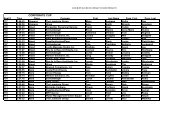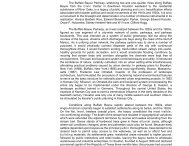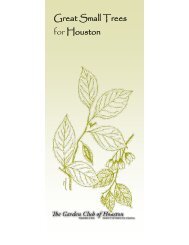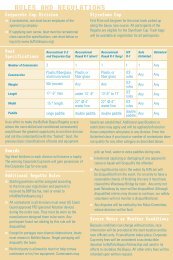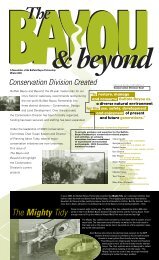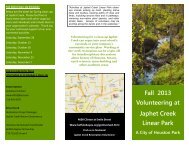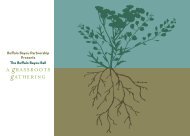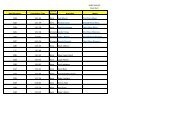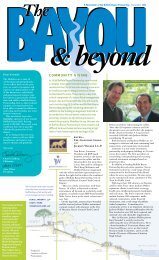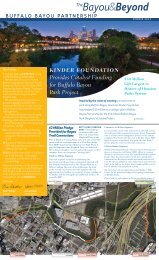Buffalo Bayou Park Vegetation Management Plan (PDF)
Buffalo Bayou Park Vegetation Management Plan (PDF)
Buffalo Bayou Park Vegetation Management Plan (PDF)
You also want an ePaper? Increase the reach of your titles
YUMPU automatically turns print PDFs into web optimized ePapers that Google loves.
Chapter 6Maintenance ProceduresTypes of Pruning• Structural pruning encourages the development of one strong leader• Cleaning removes dead, diseased, broken, and weakly attached branches. This type ofpruning helps maintain tree health, prevents tree limbs from falling, and other hazardousconditions.• Reducing decreases height and/or spread. Reducing is primarily used to provide clearancefor utilities and structures and to minimize potential for failure. (overhead utility line pruning)• Thinning reduces the density of live branches. Trees may need thinning if branches are tooheavy or if there is a foliar disease problem. Thinning can increase airflow and light withinthe canopy, enhance the appearance of the tree and increase its storm resistance.• Raising provides vertical clearance so people and vehicles can move easily under a tree.Raising is best done by reducing the length of the branch (cutting back to a lateral branch)instead of completely removing the branch.Pruning CutsVisible branch collarAt the base of the branch, where it meets the trunk, there is often an enlarged area call thebranch collar. The raised bark that develops at the angle of attachment between the branch andthe trunk is the branch bark ridge. It is best to cut as close as possible to the branch bark ridgeand branch collar at the base of the branch without damaging either one. Cutting just outside thebranch collar offers several advantages:• Prevents damage to the trunk tissue• Limits possibility of trunk tissue decay• Retains branch collar as natural protective area• Creates a smaller woundHow to Make the Pruning CutHow the cut is made is as important as where it is made. Removing a limb larger than 1 inch indiameter should be done with three cuts.1 A partial undercut to keep the branch from tearing bark as it is removed.2 A cut through the entire branch slightly farther out than the undercut to remove the branch.On small limbs (less than 1 ¾ inch) a lopper may be used to do this.3 A cut just beyond the branch collar and branch bark ridge to remove the stub.FertilizingDetermining if a Tree Needs FertilizerExamining the tree and the site and conducting foliar and soil analysis will help determinefertilization needs. Fertilizing trees that are under stress, such as newly planted, root damaged,or diseased trees, is not recommended because the tree usually does not have the energyreserves necessary for the increased growth that will occur due to fertilization. Gilman (1997)recommends that during the establishment period, maintenance resources should be restricted towatering, mulching and weed control.Examine the TreeExamine the tree for any abnormalities in leaf color, leaf size, and twig growth rate, which may besymptomatic of a nutrient imbalance. For example, a lack of nitrogen will turn foliage yellow, butit is not the only cause of yellow leaves.October 2004 43 <strong>Buffalo</strong> <strong>Bayou</strong> <strong>Park</strong> <strong>Vegetation</strong> <strong>Management</strong> <strong>Plan</strong><strong>Buffalo</strong> <strong>Bayou</strong> Partnership




